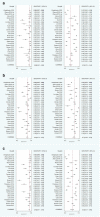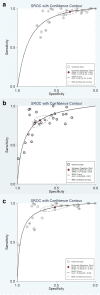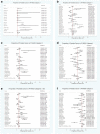Impact of PI-RADS Category 3 lesions on the diagnostic accuracy of MRI for detecting prostate cancer and the prevalence of prostate cancer within each PI-RADS category: A systematic review and meta-analysis
- PMID: 33002371
- PMCID: PMC7934301
- DOI: 10.1259/bjr.20191050
Impact of PI-RADS Category 3 lesions on the diagnostic accuracy of MRI for detecting prostate cancer and the prevalence of prostate cancer within each PI-RADS category: A systematic review and meta-analysis
Abstract
Objective: To evaluate Prostate Imaging Reporting and Data System (PI-RADS) category 3 lesions' impact on the diagnostic test accuracy (DTA) of MRI for prostate cancer (PC) and to derive the prevalence of PC within each PI-RADS category.
Methods: MEDLINE and Embase were searched until April 10, 2020 for studies reporting on the DTA of MRI by PI-RADS category. Accuracy metrics were calculated using a bivariate random-effects meta-analysis with PI-RADS three lesions treated as a positive test, negative test, and excluded from the analysis. Differences in DTA were assessed utilizing meta-regression. PC prevalence within each PI-RADS category was estimated with a proportional meta-analysis.
Results: In total, 26 studies reporting on 12,913 patients (4,853 with PC) were included. Sensitivities for PC in the positive, negative, and excluded test groups were 96% (95% confidence interval [CI] 92-98), 82% (CI 75-87), and 95% (CI 91-97), respectively. Specificities for the positive, negative, and excluded test groups were 33% (CI 23-44), 71% (CI 62-79), and 52% (CI 37-66), respectively. Meta-regression demonstrated higher sensitivity (p < 0.001) and lower specificity (p < 0.001) in the positive test group compared to the negative group. Clinically significant PC prevalences were 5.9% (CI 0-17.1), 11.4% (CI 6.5-17.3), 24.9% (CI 18.4-32.0), 55.7% (CI 47.8-63.5), and 81.4% (CI 75.9-86.4) for PI-RADS categories 1, 2, 3, 4 and 5, respectively.
Conclusion: PI-RADS category 3 lesions can significantly impact the DTA of MRI for PC detection. A low prevalence of clinically significant PC is noted in PI-RADS category 1 and 2 cases.
Advances in knowledge: Inclusion or exclusion of PI-RADS category 3 lesions impacts the DTA of MRI for PC detection.
Conflict of interest statement
Figures





Similar articles
-
Use of the Prostate Imaging Reporting and Data System (PI-RADS) for Prostate Cancer Detection with Multiparametric Magnetic Resonance Imaging: A Diagnostic Meta-analysis.Eur Urol. 2015 Jun;67(6):1112-1121. doi: 10.1016/j.eururo.2014.10.033. Epub 2014 Nov 6. Eur Urol. 2015. PMID: 25466942 Review.
-
Risk Stratification of Prostate Cancer According to PI-RADS® Version 2 Categories: Meta-Analysis for Prospective Studies.J Urol. 2020 Dec;204(6):1141-1149. doi: 10.1097/JU.0000000000001306. Epub 2020 Jul 27. J Urol. 2020. PMID: 32716687
-
Comparison of PI-RADS version 2 and PI-RADS version 2.1 for the detection of transition zone prostate cancer.Eur J Radiol. 2019 Dec;121:108704. doi: 10.1016/j.ejrad.2019.108704. Epub 2019 Oct 17. Eur J Radiol. 2019. PMID: 31669798
-
Risk of Clinically Significant Prostate Cancer Associated With Prostate Imaging Reporting and Data System Category 3 (Equivocal) Lesions Identified on Multiparametric Prostate MRI.AJR Am J Roentgenol. 2018 Feb;210(2):347-357. doi: 10.2214/AJR.17.18516. Epub 2017 Nov 7. AJR Am J Roentgenol. 2018. PMID: 29112469
-
Comparison of diagnostic performance and inter-reader agreement between PI-RADS v2.1 and PI-RADS v2: systematic review and meta-analysis.Br J Radiol. 2022 Mar 1;95(1131):20210509. doi: 10.1259/bjr.20210509. Epub 2021 Sep 14. Br J Radiol. 2022. PMID: 34520694 Free PMC article.
Cited by
-
Molecular and diffusion features for identification of clinically significant prostate cancer in PI-RADS 3 lesions.Urol Oncol. 2024 Nov;42(11):370.e9-370.e14. doi: 10.1016/j.urolonc.2024.05.025. Epub 2024 Jul 8. Urol Oncol. 2024. PMID: 38971674
-
Simplified PI-RADS (S-PI-RADS) for biparametric MRI to detect and manage prostate cancer: What urologists need to know.Turk J Urol. 2021 May;47(3):175-182. doi: 10.5152/tud.2021.21004. Turk J Urol. 2021. PMID: 35929870 Free PMC article.
-
Comparison of different thresholds of PSA density for risk stratification of PI-RADSv2.1 categories on prostate MRI.Br J Radiol. 2022 Mar 1;95(1131):20210886. doi: 10.1259/bjr.20210886. Epub 2021 Nov 11. Br J Radiol. 2022. PMID: 34762506 Free PMC article.
-
Artificial intelligence as diagnostic aiding tool in cases of Prostate Imaging Reporting and Data System category 3: the results of retrospective multi-center cohort study.Abdom Radiol (NY). 2023 Dec;48(12):3757-3765. doi: 10.1007/s00261-023-03989-9. Epub 2023 Sep 22. Abdom Radiol (NY). 2023. PMID: 37740046
-
Can we rely on magnetic resonance imaging for prostate cancer detection and surgical planning? Comprehensive analysis of a large cohort of patients undergoing transperineal mapped biopsies.World J Urol. 2024 Sep 30;42(1):548. doi: 10.1007/s00345-024-05233-5. World J Urol. 2024. PMID: 39347947
References
-
- Mulhem E, Beaumont W, Heights S, Fulbright MN, Hospital P, Lyon S, et al. . Prostate cancer screening. 2015;.
Publication types
MeSH terms
LinkOut - more resources
Full Text Sources
Other Literature Sources
Medical
Research Materials
Miscellaneous

